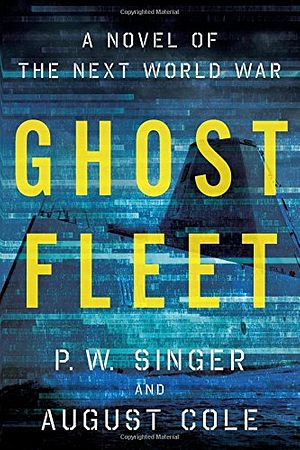Writing about the future of geopolitics is a challenging task. Writers are asked to mix politics, social developments, and science in a way that is interesting enough to attract an audience and credible enough to retain their attention. In that sense, P.W. Singer and August Cole’s Ghost Fleet is a success. The two authors, with backgrounds in Washington-based foreign policy think tanks, balance thorough research in defense technology with ongoing geopolitical developments to create a highly believable vision for what the next world war could look like. Their clear investment into research with defense and security technical experts could well have yielded a complete text book on its own. However, readers have the luxury of enjoying their hard work through a fictional story that pits the United States, China, and Russia in the next generation of warfare. [Ed. note: This review may contain minor spoilers.]
The book’s title, Ghost Fleet, comes from an expression used in the U.S. Navy that refers to partially or fully decommissioned ships kept in reserve for potential use in future conflict. These ships, as one might imagine, are older and naturally less technologically sophisticated than their modern counterparts. Singer and Cole cleverly use this concept, retiring older ships and weaponry in favor of newer versions with higher technological integration, to illustrate a key motif in the book: while America’s newest generation of warfighting machinery and gear is capable of inflicting greater levels of punishment, it is also vulnerable to foreign threats in ways that its predecessors were not. The multi-billion dollar, next generation F-35 aircraft, for instance, is rendered powerless after it is revealed that Chinese microprocessor manufacturers had implanted malicious code into products intended for the jet.
The bulk of fighting takes place on the traditional battlegrounds of air, land, and sea. Chinese forces take advantage of their unsuspecting American counterparts and launch a familiar-sounding surprise attack on the U.S. naval base at Pearl Harbor. The attack had been precipitated by a Chinese gas discovery near the Mariana Trench, giving the Chinese government, known as the Directorate, enough leverage to act without fear for economic sanctions from the United States. The battles that ensue feature new weapons systems such as the U.S. Navy’s railgun, synthetic “stims” that boost soldiers’ reaction time and alertness, and unmanned aerial combat drones that rely on computer programs to engage enemy warplanes in high speed dogfights that would have strained even the fittest human flying aces. Young officers and enlistees on all sides also wear “viz” glasses that many will likely recognize as descendants of Google’s Google Glass.
For all of their emphasis on cutting edge technology in traditional planes of fighting, however, Ghost Fleet’s authors also show readers what warfare might look like on two completely new planes as well: cyber and outer space. Imaginative science fiction writers have treaded these realms for years, but few have done so with the concrete expertise and insight of Singer and Cole. China’s successful use of a space-based laser to preemptively disable American military satellites and communications equipment, for instance, has no precedent in history, but Singer and Cole might argue that the scenario is fast becoming a possibility as space technology continues to evolve. Indeed, the opening pages of the book feature the deadly betrayal of an American astronaut by his Russian counterparts on the international space station, reminding the reader that tomorrow’s wars, like national allegiance, will not be tethered to lines on the earth.
If there is one area in which Singer and Cole sometimes fall short of their goal of crafting a book that both educates and entertains readers, it is in the fictional thread that holds together the secondary, interpersonal plot. The story of the third world war unfolds before the reader from multiple perspectives, including those of an emotionally estranged father and son who are serving together on one of the U.S. Navy’s premier ships, a seductive surf instructor nicknamed the “Black Widow” for her near obsession with seducing and slaying Chinese soldiers in Hawaii, and an eccentric billionaire turned space pirate. For all of the peculiarities that make these characters interesting, they do little to maintain the serious, credible tone of a book about war. Nonetheless, despite the shortcomings in character depth and development, the book’s grounding in technical expertise and geopolitical strategy more than makes up for any lack of depth in any of the characters.
Singer and Cole’s Ghost Fleet scores highly in its ability to communicate cutting edge, and futuristic technical concepts about warfare and equipment, while setting the stage for a compelling geopolitical showdown between some of the world’s most powerful militaries. Inevitably, many readers will dismiss some of the technology the writers describe as the stuff of science fiction books or movies, casting doubt on the plausibility of some of the book’s more technical aspects. Yet the thoroughness and authority the two authors bring to the Ghost Fleet is what places the book in a category of its own, and apart from mainstream science fiction, making it worthy of serious reflection. Ghost Fleet’s primary aim is to inform security and defense professionals, just as its character-filled narrative serves to translate sophisticated technical concepts with practical, if fictional, illustrations. The book provides readers with an unquestioningly plausible vision for what could one day become the reality of great power war.
Gary Bearden is a foreign policy professional and current Political Risk Fellow with Young Professionals in Foreign Policy (YPFP). He has professional and living experience in Eastern Europe, North Africa and Latin America, holds three Bachelors degrees from Ohio State University and a Master of Science in Foreign Service from Georgetown University.
































